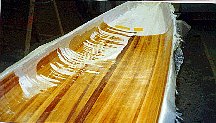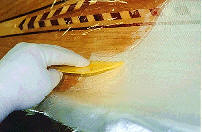
 |
||||
| INDEX | next
|
 |
The
inside surfaces require a different technique. A large batch is poured inside. The procedure here
is similar but the wet-out and squeegeeing need a bit more care and attention. The cloth is easily
dislodged with too much squeegee pressure. Note, that unlike the outside surfaces, both sides are
done at the same time. The pooling epoxy makes no distinction between the left or right boundary
so it is better to do both sides together. 'If you can't fight them, join them!' Swiping alternately from the keel to the sheerline and vice versa gets the resin out easily without sliding the fabric around. Watch out for late forming bubbles. Now that the outside surface is sealed the trapped air (curing epoxy heats up and expands the air pockets) has no place to escape but through your fresh lay-up. Also, some pinholes may not be filled and the epoxy slowly trickles in displacing the air bubble. |
 |
Resin
starvation is never a problem here. Spread the epoxy as thin as you can
right from the beginning. The inside surfaces need no extra epoxy coats to hide the weave of the fabric. The only place that should have more protection is the cockpit area as well as the under deck around the knees and the hatches. Find tips and how different epoxies look on the Epoxy Test page. |
| INDEX |
| Home | Kayak Designs | Kayak Shop | Materials | Kayak Gallery | About us |
| Building Manual | Plans | Sandwich Core | Wood Kayak | Order | |
| Epoxy Test | Abrasion Cloth | Rudder | Resources | Choosing Kayak | Guestbook |
If you notice any problems with the site (i.e. error links, missing images) please, let me know. Thanks
Mail:
Vaclav Stejskal
10 Colonial Court apt. 73
Stoneham, MA. 02180
USA
Tel: 781-481-9261
© 1999
- 2020 Copyright Vaclav Stejskal
All rights reserved
Last page update:
11 January 2020